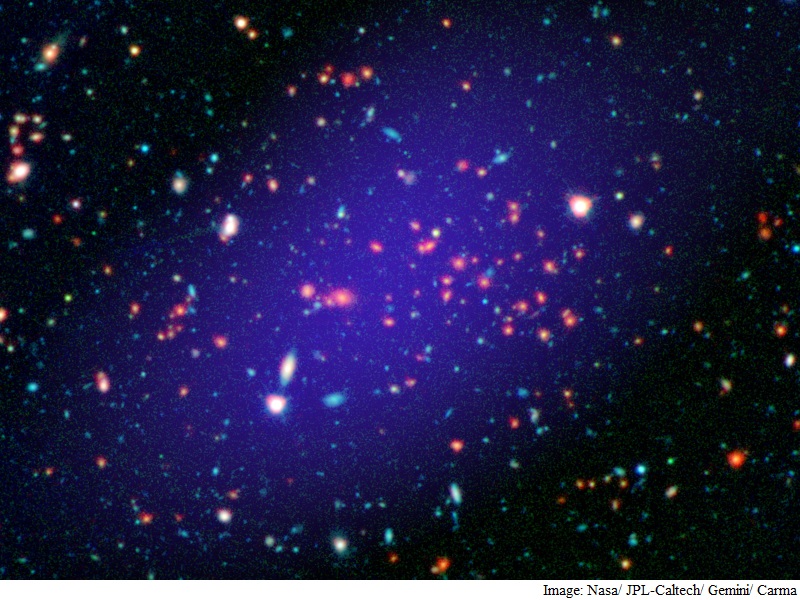- Home
- Science
- Science News
- Strange Radio Bursts From Space Come in Clusters: Study
Strange Radio Bursts From Space Come in Clusters: Study

Mysterious and powerful radio waves from deep space are coming in clusters, scientists revealed on Wednesday, having only discovered their existence a decade ago.
The repeated pulses emanate from well beyond the edge of the Milky Way Galaxy, according to a study published in the journal Nature.
It was previously thought that these so-called fast radio bursts (FRBs) - which can emit as much energy in a millisecond as the Sun emits in 10,000 years - were one-off phenomena.
Less than 20 have been detected since 2007, though more than 10,000 are suspected to occur every day.
Their origins remain unknown. Up to now, astronomers speculated that they were produced by cataclysmic events such as stars exploding into a supernovas, or neutron stars collapsing into black holes.
But none of these scenarios are consistent with multiple pulses, leaving scientists at a loss as to how to interpret the new data.
Peter Scholz, a graduate student at the McGill Space Institute at McGill University in Montreal and a co-author of the paper, discovered evidence of the bursts in November while sifting through data gathered by the Arecibo telescope in Puerto Rico.
"I knew immediately that the discovery would be extremely important in the study of FRBs," Scholz said in a statement.
The telescope, the largest of its kind, had picked up a total of 10 radio wave pulses, all grouped within the space of a minute.
"Not only did these bursts repeat, but their brightness and spectra also differ from those of other FRBs," said Laura Spitler, lead author and a researcher at the Max Planck Institute for Radio Astronomy in Bonn, Germany.
The latest findings appear to be at odds with research published only last week in Nature that concluded that FRBs are generated by one-off cataclysms.
But it is now thought that there could be two or more sources for frequent radio bursts.
The researchers speculated that multiple pulses could come from an "exotic object" such as a hugely powerful, rotating neutron star.
Locating the galaxy from which the serial burst came would be "critical to understanding its properties," said Jason Hessels, a co-author of the study and a professor at the University of Amsterdam.
Pinpointing the source could also tell astronomers how long it took for the waves to reach Earth, a voyage likely measured in billions of light years.
Comparing theoretical travel time in a vacuum with actual travel time could shed light on the distribution of matter in the universe.
Catch the latest from the Consumer Electronics Show on Gadgets 360, at our CES 2026 hub.
Related Stories
- Samsung Galaxy Unpacked 2025
- ChatGPT
- Redmi Note 14 Pro+
- iPhone 16
- Apple Vision Pro
- Oneplus 12
- OnePlus Nord CE 3 Lite 5G
- iPhone 13
- Xiaomi 14 Pro
- Oppo Find N3
- Tecno Spark Go (2023)
- Realme V30
- Best Phones Under 25000
- Samsung Galaxy S24 Series
- Cryptocurrency
- iQoo 12
- Samsung Galaxy S24 Ultra
- Giottus
- Samsung Galaxy Z Flip 5
- Apple 'Scary Fast'
- Housefull 5
- GoPro Hero 12 Black Review
- Invincible Season 2
- JioGlass
- HD Ready TV
- Laptop Under 50000
- Smartwatch Under 10000
- Latest Mobile Phones
- Compare Phones
- OPPO Reno 15 Pro Max
- Honor Win RT
- Honor Win
- Xiaomi 17 Ultra Leica Edition
- Xiaomi 17 Ultra
- Huawei Nova 15
- Huawei Nova 15 Pro
- Huawei Nova 15 Ultra
- Asus ProArt P16
- MacBook Pro 14-inch (M5, 2025)
- OPPO Pad Air 5
- Huawei MatePad 11.5 (2026)
- Xiaomi Watch 5
- Huawei Watch 10th Anniversary Edition
- Acerpure Nitro Z Series 100-inch QLED TV
- Samsung 43 Inch LED Ultra HD (4K) Smart TV (UA43UE81AFULXL)
- Asus ROG Ally
- Nintendo Switch Lite
- Haier 1.6 Ton 5 Star Inverter Split AC (HSU19G-MZAID5BN-INV)
- Haier 1.6 Ton 5 Star Inverter Split AC (HSU19G-MZAIM5BN-INV)

















